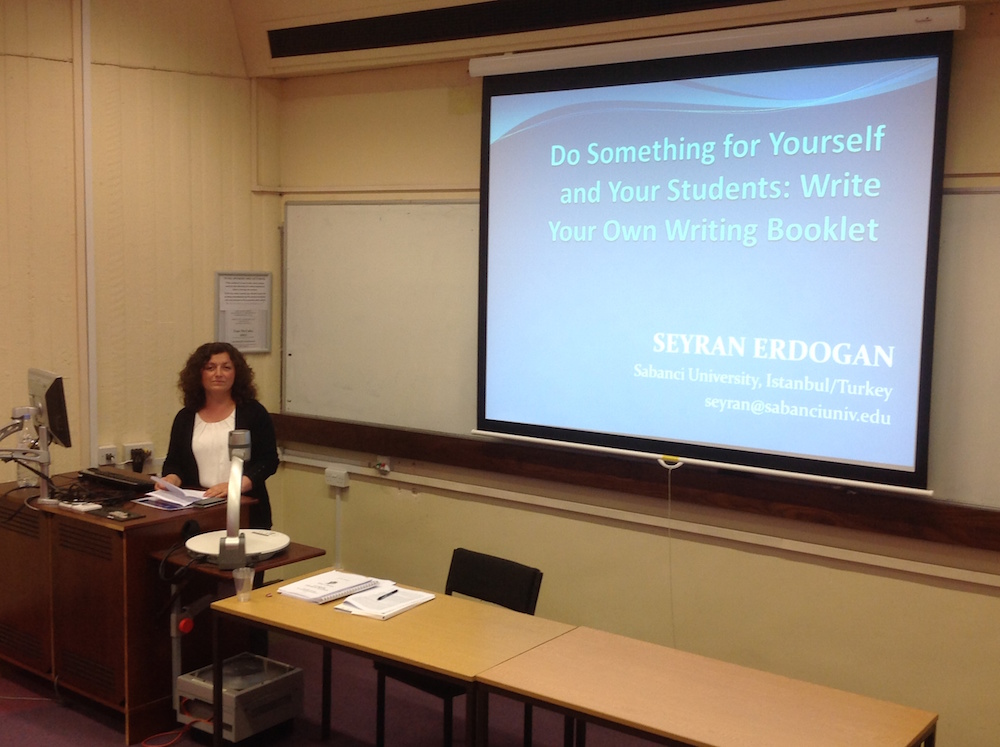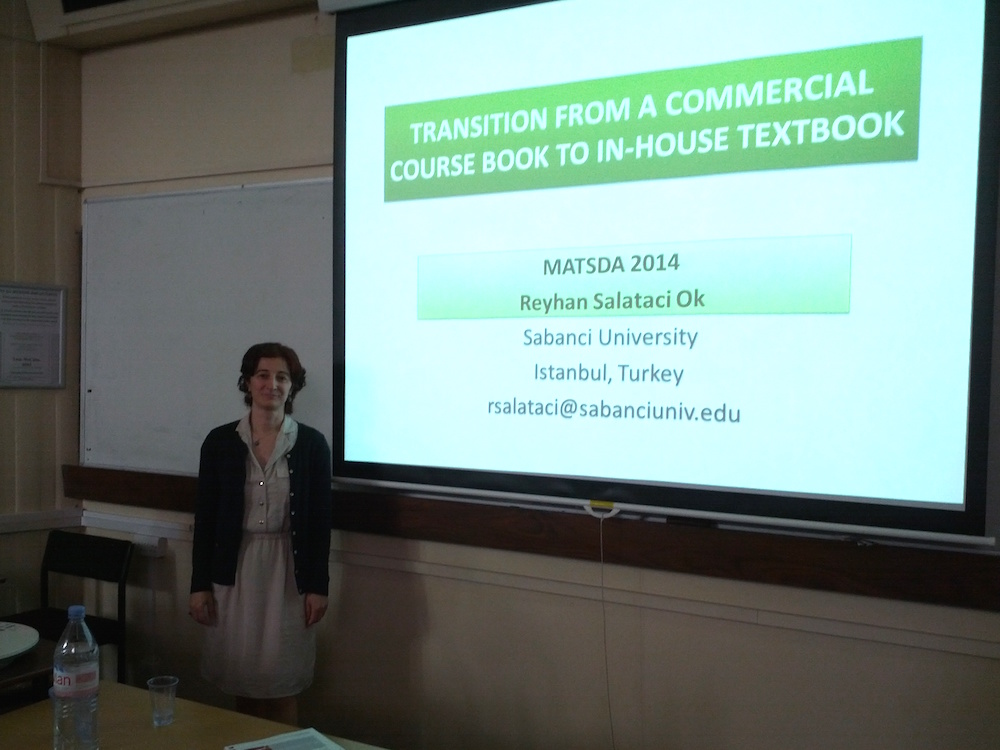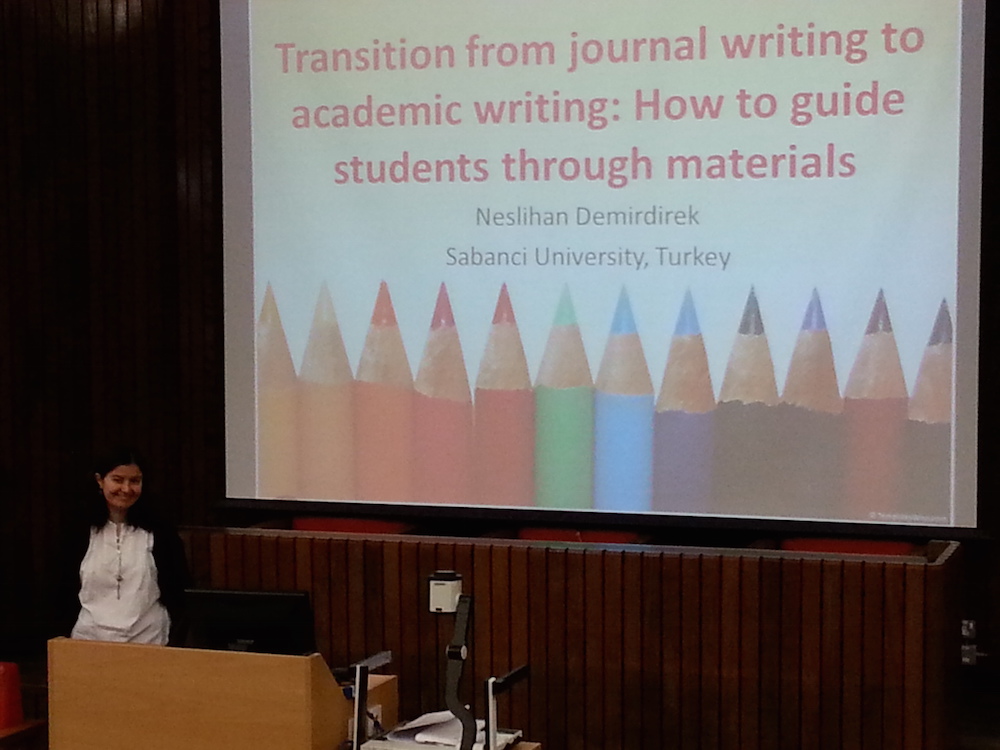
MATSDA CONFERENCE - JUNE 28/29, LIVERPOOL UK
Seyran Erdoğan, Neslihan Demirdierek & Reyhan Salatacı Ok
MATSDA, or Materials Development Association held its annual conference in association with The University of Liverpool at the last weekend of June. The organization was founded and is headed by Brian Tomlinson, whom most of us know for his books on materials. The conference, which he organized, gave those who attended the chance to meet some of the biggest names in ELT.
The conference opened with Tomlinson's own plenary in which he examined the connection between the SLA research and ELT materials. He asserted that in many countries and contexts students suffer from the coursebook because the material in it does not match what we know about SLA, reason being that schools are more interested in exams (and revision of material) rather than the principles of language acquisition. He thinks that a coursebook that matches the principles of language acquisition would not achieve face validity and it would not sell. He then listed five principles that materials should follow to provide effective learning:
Learners should be
1. exposed to an input of language in use which is: rich (quality & quantity); recycled; meaningful; comprehensible
2. affectively engaged.
3. cognitively engaged.
4. sometimes helped to pay attention to form whilst or after focusing on the meaning.
5. given plentiful opportunities to use the language for communication.
He concluded his plenary saying that TTT (Teacher, Texts and Tasks) will lead to more successful learning.
The second plenary was given by Hitomi Masuhara, whose interest area is brain studies. She explained two main findings from brain studies and their implications for materials development:
1. We feel, therefore, we learn. (Emotion is pervasive and it determines whether one learns or not)
Implication: Materials should encourage affective engagement as well as cognitive development. Therefore, they should offer appeal, fun, play, goal, self-esteem and confidence to the learner.
2. Mental representation is multi-dimensional. (Information is processed in different places in the brain)
Implication: Materials should encourage multi-dimensional processing. In other words, they should lead to visualizing, hearing, tasting, smelling, touching, thinking and feeling.
She finished her session suggesting that form-focused creative tasks are the ones to achieve the points she had mentioned. Hitomi also provided the listeners with a list of websites about brain studies. Some of them: www.brainfacts.org / www.kavlifoundation.org/brain-initiative / www.sfn.org/about/what-we-do
Another plenary speaker was Rod Ellis, who focused on the difference between the intended aim of a task and what actually happens when learners are actually engaged in that task. He described materials as work plans to be implemented in class which elicit text manipulation and text creation. He said that ideally materials should elicit text creation. He then went on to explain some factors that teachers can consider when evaluating work plans:
Does the workplan
1. pre-suppose a primary focus on meaning or form?
2. afford some kind of gap?
3. require learners to use their own linguistic resources?
4. expect a purely linguistic or a communicative outcome?
Rod Bolitho's plenary was on the factors that play a role when materials are being written. He listed and explained factors like traditions and beliefs, theories, ideas, context, learners and texts. After explaining each factor, he stated the typical dilemmas and problems for each one. In the final part of his talk, he stated that teaching and learning are complex processes and that the textbooks should reflect it. He finished his talk by suggesting a team approach to authoring so that multiple ways of thinking will be included, responsibilities will be shared and a range of learning styles will be reflected in the material produced.
Pauline Foster, who is an SLA researcher, started her talk with the history of language teaching, and then explained some findings from SLA and materials research:
1. Pre-task planning lead to greater complexity, fluency and accuracy.
2. Familiarity with the information leads to greater accuracy.
The last and perhaps the most interesting plenary was given by Alan Maley, who titled his talk "'We need more research.' Who says so?" He asserted that the field of ELT is dominated by researchers and they often make teachers feel worthless. He went on to explain why most research is useless. Later, he explained the factors that brought about the greatest changes in ELT, which, of course, were not research related. Maley, then, listed the characteristics of good research for teachers (relevant, reliable, generalizable, comparable, replicable, accessible, communicable and applicable), and explained the problems with much of linguistic research. He finished off his talk by giving the reasons why teachers do not do much research and some alternatives to research for teacher development such as talking shops to reflect, inquiry, materials development, exploring ‘preparedness’.
In addition to these very informative and inspirational plenaries, there were many interesting concurrent sessions, some of which we were able to attend.
In her session titled “What about the other 165 hours a week?” Lisa Pinard talked about the scaffolding strategies she used to have her students do more effective outside study, among which were reading, experimenting with language, helping learners become language researchers, using collaborative tools and a task based module she herself created. Although she carried out this work at a language school where students received only 3 hours’ of instruction, the work she has done is relevant and applicable in other contexts.
Nigel Harwood’s session was on what we can learn from mainstream textbook research. This was actually a kind of a summary of a chapter he was writing for a book. He started by explaining why it matters and on what levels textbooks can be analyzed. He then explained, with examples, how textbook research can contribute to teaching. He concluded that textbook use depends on the context (school, curriculum, tests, teachers’ beliefs and practices).
Ali Ata Akhaldi, who teaches in the UAE, described in detail the framework he developed to evaluate materials and the principles that materials should follow. His reasoning was that questionnaires may not reveal the real value of a textbook and that to evaluate it better locally, sensitive evaluation instruments need to be designed.
Gael Morag McFarlane described the project work she and her colleagues implemented with their students in Koç University. She said they had 5 extra hours where they get students to do projects especially to let them have more speaking practice. The project has been successful for many reasons one of them being that there is now a speaking part in their proficiency exam. She later showed the audience some videos that students had made during the course.
Two of the parallel sessions we attended were concerned with writing of a textbook. Farida Abderrahim from Algeria explained how she created a grammar textbook for their university students based on structural and communicative language teaching methods. She explained that in her textbook she followed an explicit grammatical formula (paying attention to form and meaning) with a collection of authentic texts. It would have been good to see a sample unit in the presentation. The other textbook writer Isora Enriquez O’Farril was from Cuba. She described how they created a new textbook for Cuban learners. She explained that with the change in the socio-cultural life of the people in the country, a need to understand and interact with people outside Cuba emerged. She stated that an important factor which motivated them to create their own textbook is that obtaining textbooks printed by international companies is very costly. Another important factor is that they wanted to incorporate cultural elements (such as the life of Fidel Castro) and address their educational needs in the textbooks (such as public sex education). The textbooks that they produced are free of charge and therefore it is printed in black and white. All these print materials are also supported by visual aid in the form of TV programmes. Many children and young people are educated with the help of educational programmes on their public TV channels. I liked the fact that they used their own culture and interdisciplinary approach in the course books and of course that they are free.
Emily Edwards from Australia talked about how action research could inform materials development. She reported that she had joined a 9-month research project group that learn and apply the principles of action research in their classroom. Her project involved academic writing and assessment rubrics. She provided her students with peer assessment tools and rubrics (e.g. I need to improve my spelling by…), editing checklist (I will improve my coherence…) and goal setting (e.g., I did this and it helped me …). She claimed that this type of research helped her gain more insight into how to improve her students’ writing skill. She concluded that action research even at a small scale can contribute to individual teacher development, teaching itself as a profession and political empowerment (i.e., gives us evidence to introduce changes.). Her own project reminded me of the learner-reflection part of our Learner Portfolio. We have been actually applying action research by collecting and analyzing students’ feedback to the materials and tests we have.
Wenxue Chen from the University of Nottingham gave a session called ‘Task Type, Interactional Patterns, and Focus on Form: Implications for Materials Design’. She reported her research that investigated 18 Chinese university learners while completing dictogloss, jigsaw and interview tasks. All tasks were targeted at enhancing their use of the simple past tense. She shared the details about her study and concluded that dictogloss helped learners more to improve their use of simple past tense.

I (Seyran) gave a session on the writing booklets we have for R4 and R5. My talk started with the kind of writing we teach and why we cannot use commercial academic writing books available on the market. Then, I explained why this initiative started and developed. I showed some example units from the booklets and finished my session by going over some of the feedback we have received from teachers and students on to the use of these booklets.

My own presentation (Reyhan) was about the feedback I collected both from students and teachers about Language Leader and Beyond the Boundaries. In my presentation, I first gave information about our programme and the reasons why and how we introduced a commercial textbook. I also discussed the concerns we had about the differences between the two books and how to bridge the gap. One of the authors of Language Leader came to my session and he later remarked that he was surprised when he saw one of our students’ comments about Language Leader being ‘childish.’ On the contrary, he commented that they aimed for more academic and serious content in their textbooks.

My presentation (Neslihan) was titled ‘Transition from Journal Writing to Academic Writing: How to Guide Students through Materials’. I shared how our Route 1 students start writing in English by sharing their opinions on different topics such as hobbies, leisure time activities, and favourite food. After 8 weeks of an intensive elementary course, they start writing short answers to questions based on texts in the coursebook such as study habits, learner types and cultural differences. Most students find this transition challenging and need a lot of guidance and practice. In my presentation, I shared different materials I prepared to make it a smooth transition. These include comparison of journal and short answer tasks, recognition tasks and guided production tasks. I also shared different ways of giving feedback and students’ views on the effectiveness of these materials.
Although the MATSDA Conference was a small one, we found it to be very useful in that we got to hear some big names and exchange ideas with colleagues from many different countries.
